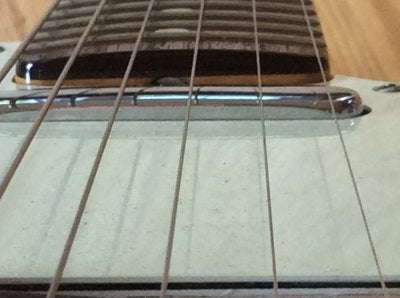In January I picked up a tele from CL -- restored USA 88 (I think) body with a 2000's MIM Joe Strummer neck. I found a photo album on the FB of the luthier who did the work:
https://www.facebook.com/pg/TheWiza...um&album_id=629181223895323&ref=page_internal
I love this guitar and really want to make it work, but it has issues: intonation, tuning stability, audible fret buzz (or the high action you need to clear it).
(I've had the nut replaced and frets leveled, and I've installed compensated saddles.)
A few observations that, to me, suggest trouble:
when you look at the bottom of the bridge, notice that the string-through holes are more visible on the low E side

top view: different size crescent moons of the body visible through the string-through holes in the bridge

traces of history
from impressions in the paint, you can see where the string-through holes originally were
part of the remarriage of 80s body and 60s repro neck I'd guess
this picture is upside down, not sure how to flip -- so the old holes were closer to the neck.

i had a hard time capturing this in a photo, but it's very visible in real life --
if you look at the gap between the pickguard and the top of the bridge,
the lines aren't parallel, they're converging, and closer on the low E side

Where to go from here.
I wouldn't be worried if these were abstract or aesthetic problems of asymmetry -- but I think that they may be a factor in what feels off about this guitar. I've sometimes said it sounds like the strings are out of tune with themselves -- like, the parabola is messed up, and the tuner can go wild trying to get a read on it.
I was thinking the least invasive thing to do would be to install a top-loader bridge -- it would still be set at the wrong angle with respect to the neck, but the string wouldn't be trying to go in a second direction after the barrel. If the string-through holes in the body and the bridge aren't lined up, I think this would put some torque into the break angle, and (in my imagination at least) could cause the string to vibrate in unhappy ways.
Here's a question -- I'm thinking about compensated saddles vs. round barrels. I can't quite picture all the geometry and physics involved. If the break angle is compromised, would it be better to have standard barrel saddles? Like, there would be a more forgiving range of points of contact, rather than a narrow edge?
Perspectives, advice, hard lessons? Thank you.
https://www.facebook.com/pg/TheWiza...um&album_id=629181223895323&ref=page_internal
I love this guitar and really want to make it work, but it has issues: intonation, tuning stability, audible fret buzz (or the high action you need to clear it).
(I've had the nut replaced and frets leveled, and I've installed compensated saddles.)
A few observations that, to me, suggest trouble:
when you look at the bottom of the bridge, notice that the string-through holes are more visible on the low E side
top view: different size crescent moons of the body visible through the string-through holes in the bridge
traces of history
from impressions in the paint, you can see where the string-through holes originally were
part of the remarriage of 80s body and 60s repro neck I'd guess
this picture is upside down, not sure how to flip -- so the old holes were closer to the neck.
i had a hard time capturing this in a photo, but it's very visible in real life --
if you look at the gap between the pickguard and the top of the bridge,
the lines aren't parallel, they're converging, and closer on the low E side
Where to go from here.
I wouldn't be worried if these were abstract or aesthetic problems of asymmetry -- but I think that they may be a factor in what feels off about this guitar. I've sometimes said it sounds like the strings are out of tune with themselves -- like, the parabola is messed up, and the tuner can go wild trying to get a read on it.
I was thinking the least invasive thing to do would be to install a top-loader bridge -- it would still be set at the wrong angle with respect to the neck, but the string wouldn't be trying to go in a second direction after the barrel. If the string-through holes in the body and the bridge aren't lined up, I think this would put some torque into the break angle, and (in my imagination at least) could cause the string to vibrate in unhappy ways.
Here's a question -- I'm thinking about compensated saddles vs. round barrels. I can't quite picture all the geometry and physics involved. If the break angle is compromised, would it be better to have standard barrel saddles? Like, there would be a more forgiving range of points of contact, rather than a narrow edge?
Perspectives, advice, hard lessons? Thank you.

